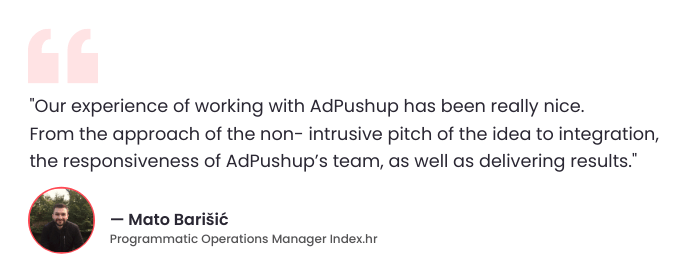Dive into comprehensive insights about the Open Ad Exchange in this exploration. Gain a deep understanding of its workings and significance in the digital advertising landscape.
Have you ever wondered how websites make money? Is it just by writing the content and posting the images? But who pays them for it?
Here’s the short answer, most websites rely on advertising to generate revenue.
But how do publishers attract the advertisers and how do advertisers know where to place their ads? That’s where ads exchange come in.
Publishers can access these ad exchanges and monetize their website by selling their ad space in real time.
Open ad exchanges are a valuable tool for publishers and advertisers alike. They can help publishers to maximize their revenue, and help publishers to reach their target audience more effectively.
Let’s take a closer look at open ad exchanges to learn more about what they are, how they work, and the benefits they provide to publishers.
What is an Open Ad Exchange?
An open ad exchange, often referred to as an open marketplace, constitutes a trade of advertisements, where media entities extend an invitation to buyers to explore and acquire their ad slots. Publishers opt to engage in these platforms as a means to tap into fresh clientele or to sell more ad space, commonly termed “remnant inventory“.
How are Open Deals Different from Other Ad Exchanges’ Deals?
Open ad exchanges are just one category in the digital advertising landscape. Unlike private ad exchanges and programmatic direct deals, open ad exchanges provide a more open and competitive environment.
Compared to private exchanges that offer a controlled space for specific advertisers and publishers or programmatic direct deals that involve pre-negotiated ad purchases, open ad exchanges are accessible to a wide range of participants.
How Does an Open Ad Exchange Work?
The mechanics behind open ad exchanges involve a series of interconnected processes culminating in the swift and seamless display of ads to the right audience. Here’s how it works:

Ad Inventory Submission
Publishers make their available ad spaces known to the open ad exchange, detailing audience demographics, placement sizes, and contextual relevance.
Bid Requests
When a user accesses a website or mobile app that has advertising space available, a bid request is generated. These requests for bids are sent to the participating advertisers on the public ad exchange.
Advertiser Bids
Advertisers analyze the bid request data, such as user behavior and site context, and submit bids indicating the maximum amount they’re willing to pay for the impression.
Real-Time Bidding (RTB)
The bids are evaluated in real-time, and the open ad exchange’s algorithm determines the winning bid. The winning advertiser’s ad is instantly displayed on the user’s screen.
Ad Display
The winning ad is served to the user, and the entire process takes just fractions of a second.
Open ad exchanges offer a dynamic and efficient platform for advertisers and publishers to engage in real-time ad transactions.
This open-source ad exchange concept is fundamental to the modern digital advertising ecosystem, connecting participants in a way that maximizes reach and revenue while maintaining a competitive and accessible environment.
What are The Benefits of Open Ad Exchanges?
Open ad exchanges have revolutionized the digital advertising landscape, offering many advantages to publishers. They allow publishers to leverage the power of real-time bidding and create a competitive marketplace, thus paving the way for increased revenue, broader reach, and heightened efficiency.
That said, let’s have a look at the benefits open ad exchanges have to offer to the publishers.
Filling Unsold Inventory
Open ad exchanges provide a lifeline for publishers with unsold ad inventory. Filling these vacant spaces with relevant ads from advertisers helps publishers to optimize their revenue streams and prevent potential revenue loss.
Flexibility in Pricing and Placement
In an open-source ad exchange, publishers can determine the minimum bid they’re willing to accept for their ad inventory. Additionally, publishers can control ad placements to ensure a seamless user experience.
Increased Competition and Value
The open and competitive nature of these open ad exchanges leads to increased competition among advertisers vying for ad space in open ad exchanges.
As a result, the value of publisher inventory is driven up, allowing publishers to command higher prices for their prime placements.
What Challenges Does an Open Ad Exchange Pose?
While open ad exchanges offer numerous benefits, they also come with their fair share of challenges and considerations that advertisers and publishers must be aware of.
Navigating these challenges effectively is crucial to ensure a thriving and secure publishing ecosystem.
Let’s look at some of the potential pitfalls and ways to address them:
Ad Quality and User Experience
One of the critical challenges in open ad exchanges is maintaining ad quality and a positive user experience. Poorly designed or intrusive ads can frustrate users and lead to ad-blocking, which impacts both publishers’ revenue and advertisers’ reach.
Addressing the Challenge: Publishers should have guidelines to ensure ads adhere to specific quality standards and do not disrupt the user experience.
Ad Fraud
Ad Frauds continues to be a major issue in the world of digital advertising. In the context of open ad exchanges, fraudulent behaviors like phony clicks and impressions can inflate prices for advertisers and degrade the efficacy of campaigns.
Addressing the Challenge: Publishers can implement fraud detection tools and partner with reputable verification services to monitor and prevent fraudulent activities within open ad exchanges. Additionally, third-party tracking and verification solutions can help verify the authenticity of ad impressions.
Brand Safety
Ensuring brand safety is essential to maintain the reputation and credibility of advertisers within open ad exchanges. Placing ads alongside inappropriate or controversial content can negatively impact brand perception in open ad exchanges.
Addressing the Challenge: Publishers can employ brand safety tools that analyze and categorize content to ensure ads are placed in suitable environments within open ad exchanges. Implementing keyword blocking and partnering with platforms that prioritize brand safety can help mitigate this risk.
Privacy and Data Protection
As data privacy regulations become more stringent, advertisers and publishers must navigate the complexities of collecting, storing, and using user data while adhering to legal requirements within open ad exchanges.
Addressing the Challenge: Open ad exchanges require publishers to adopt more open data-collecting policies and make it easy for users to exercise their right to opt out. In order to prevent legal ramifications, it is crucial to ensure compliance with rules like CCPA and GDPR.
Ad Blocking
Advertisers and publishers working inside open ad exchanges have difficulties due to the proliferation of ad-blocking software. Ad blocking is on the rise, hurting both publishers’ ability to make money from open ad exchanges and advertisers’ ability to reach their target audience.
Addressing the Challenge: Publishers can explore alternative revenue streams, such as subscription models or premium content offerings, to reduce reliance on ad revenue.
Viewability and Ad Measurement
Ensuring that the ad viewability is high, is recommended to accurately measure ad performance can be challenging, affecting campaign effectiveness and ROI within open ad exchanges.
Addressing the Challenge: Employing viewability measurement tools and technologies can help publishers monitor the visibility of their ads within open ad exchanges. Implementing proper tracking mechanisms and collaborating with reliable ad verification partners can enhance ad measurement accuracy.
How to Leverage Open Ad Exchange?
Leveraging the full potential of open ad exchanges requires a strategic approach that maximizes benefits for publishers.
These best practices can help publishers streamline their efforts, target the correct demographics, and ultimately succeed in their endeavors.
Effective Audience Targeting
Accurate audience targeting is crucial for reaching the appropriate people with the correct advertisements. Knowing who you’re trying to reach and making use of available data might help you refine your approach.
- Utilize Data Segmentation
- Leverage First-Party and Third-Party Data
Ad Creative Optimization
Compelling ad creatives are crucial to capturing users’ attention and driving engagement. Invest time in crafting visually appealing and relevant ad content.
- Test Different Creatives
- Use Responsive Design
Campaign Measurement and Optimization
If you want to get the results you want from your marketing efforts, you need to track their progress and make adjustments based on the numbers.
- Set Clear Objectives
- Regularly Monitor and Analyze Data
- Perform A/B Testing
Ad Placement Strategy
The success of your campaigns may hinge, in large part, on your ability to strategically place ads through open ad exchanges.
- Maintain Contextual Relevance
- Focus on Placement Diversity
Budget Allocation and Bid Strategy
Optimizing your budget allocation and bid strategy is vital to achieving the best ROI.
- Allocate Budget Wisely
- Bid Strategically
Continuous Learning and Adaptation
Being up-to-date is crucial in the ever-changing world of digital advertising.
- Stay Informed
- Iterate and Improve
What are the Alternatives to Open Ad Exchange?
When it comes to buying and selling digital ad space, there are a number of options outside open ad exchanges. Here are a few important choices to consider:
Private Ad Exchanges
These platforms connect a restricted group of advertisers with publishers, and participation is by invitation only. Private ad exchanges provide for more granular management of inventory and the development of direct connections between buyers and sellers while retaining some of the benefits of programmatically purchased ads.
Programmatic Direct
In this model, advertisers and publishers negotiate direct deals, bypassing the auction-based nature of ad exchanges like the open ad exchange. It allows for more premium inventory and guaranteed placements.
Private Marketplaces (PMPs)
Private marketplace deals are a hybrid approach where publishers offer specific ad inventory to a pre-selected group of advertisers through a controlled auction. It provides a degree of exclusivity and transparency.
Direct Negotiations
Some advertisers and publishers still engage in traditional direct negotiations for ad placements. It involves more manual processes but offers more control over ad placements and pricing.
The Bottom Line
Open ad exchanges function as transparent and real-time auction platforms, connecting advertisers and publishers seamlessly. They offer a wealth of benefits to both sides of the equation.
Publishers can leverage open ad exchanges to fill unsold inventory, exercise pricing control, and stimulate competition among advertisers to increase the value of their ad spaces.
While open ad exchanges offer immense potential, they come with challenges like ad quality, fraud, and brand safety concerns.
However, advertisers and publishers can successfully navigate these challenges by implementing strategies such as effective targeting, creative optimization, and robust measurement techniques.
As we conclude, remember that open ad exchanges are more than just a marketplace—they represent the bridge between innovation and engagement, enabling advertisers and publishers to connect with their audiences in meaningful and impactful ways.
FAQs on Open Ad Exchange
Advertisers and publishers can meet on an open ad exchange to trade ad space in a transparent, auction-style marketplace. It’s a free-for-all market where everyone can buy and sell ads in complete openness.
One example of an ad exchange is “DoubleClick Ad Exchange” (now known as Google Ad Manager). It facilitates programmatic ad buying and selling, connecting advertisers with publishers to optimize ad placements.
Google Ads is not an ad exchange but a platform for creating, managing, and serving ads across Google’s network of properties. Google Ad Manager, on the other hand, is an ad exchange that connects advertisers and publishers for programmatic ad transactions.

Nidhi Mahajan is a content author with a remarkable talent for ad tech. With a deep understanding of the ad tech industry and a sharp focus on detail, she excels in crafting insightful articles and compelling narratives. Nidhi is dedicated to making the complexities of ad tech more accessible to all through her clear and informative writing.







